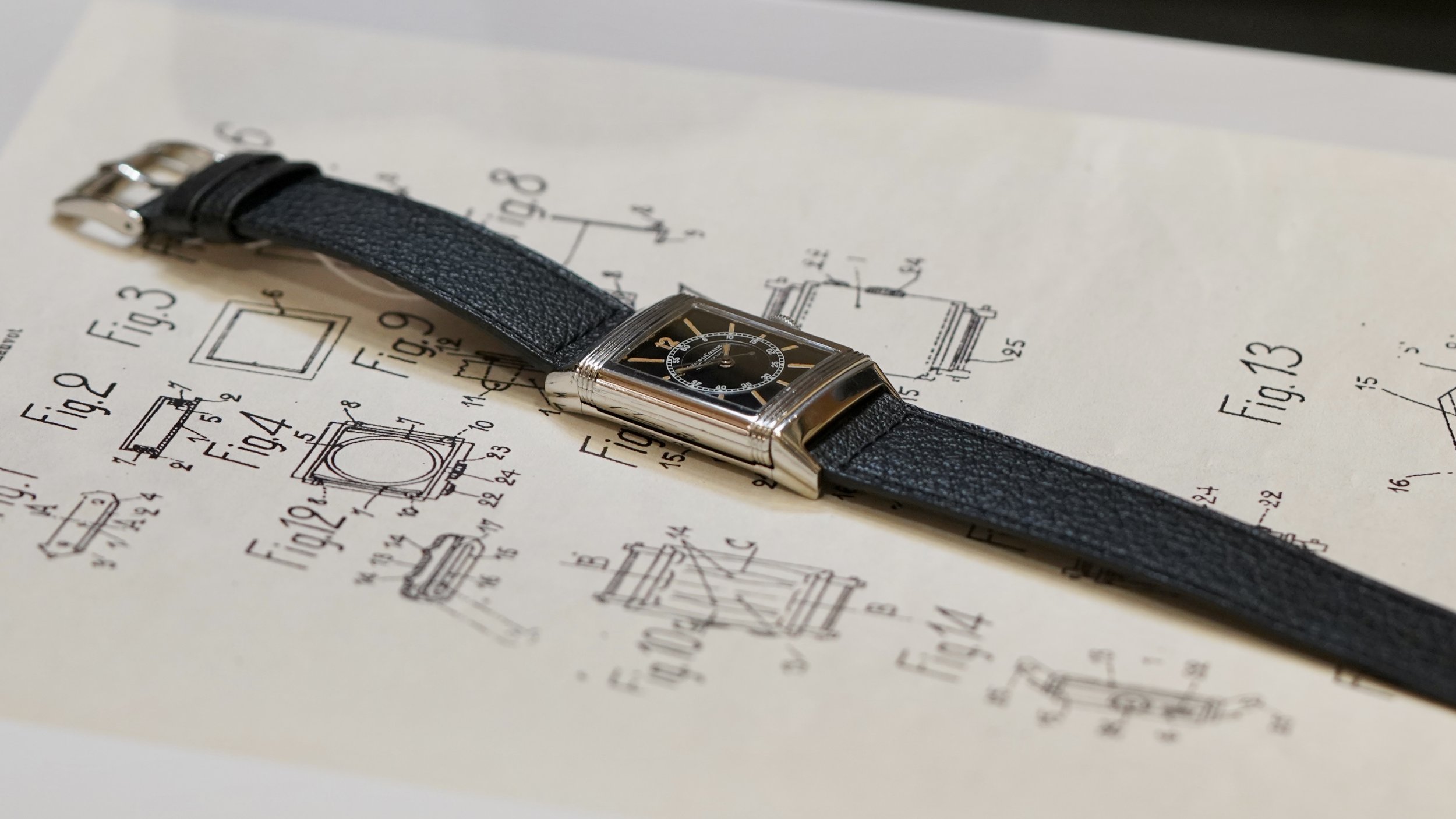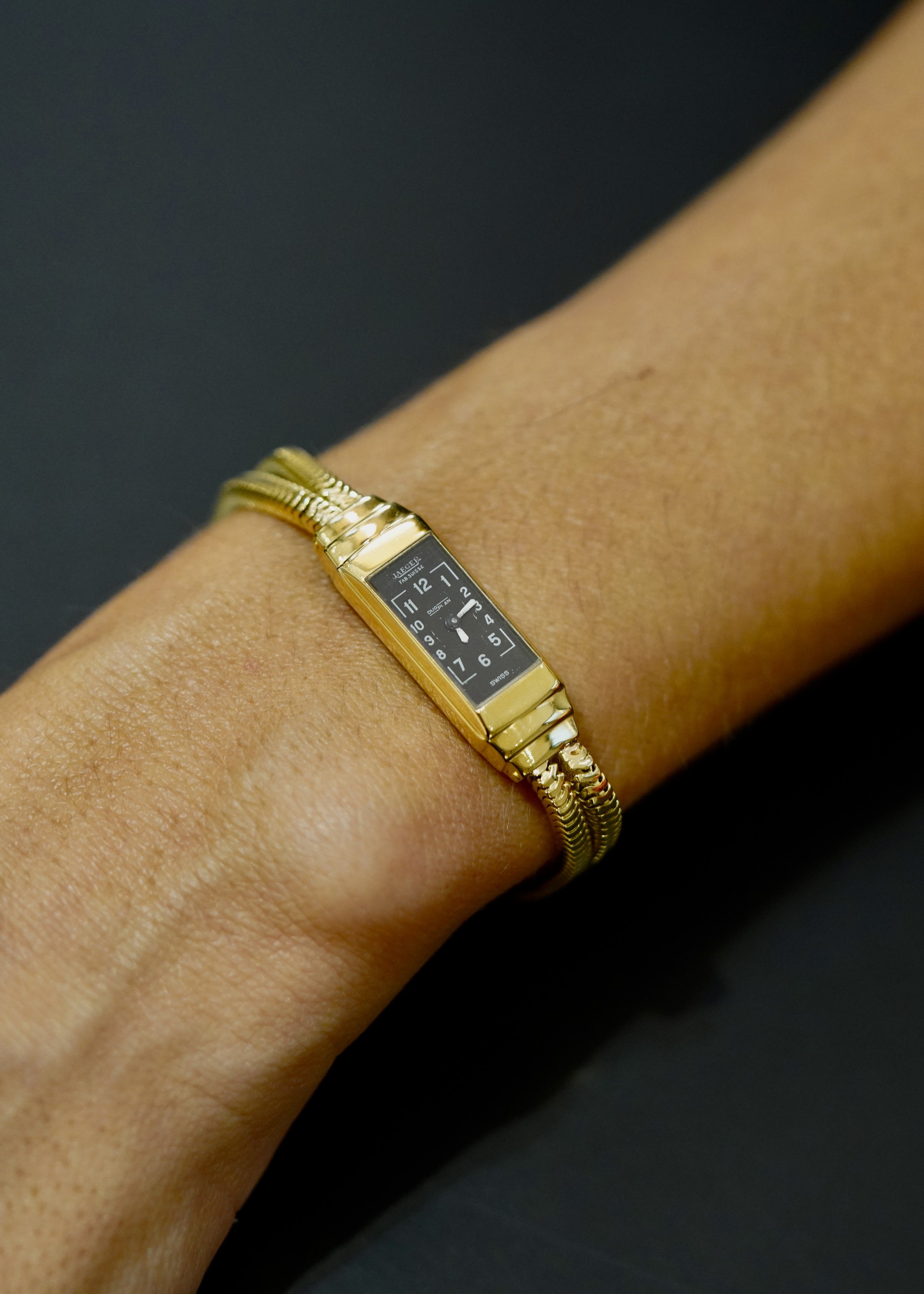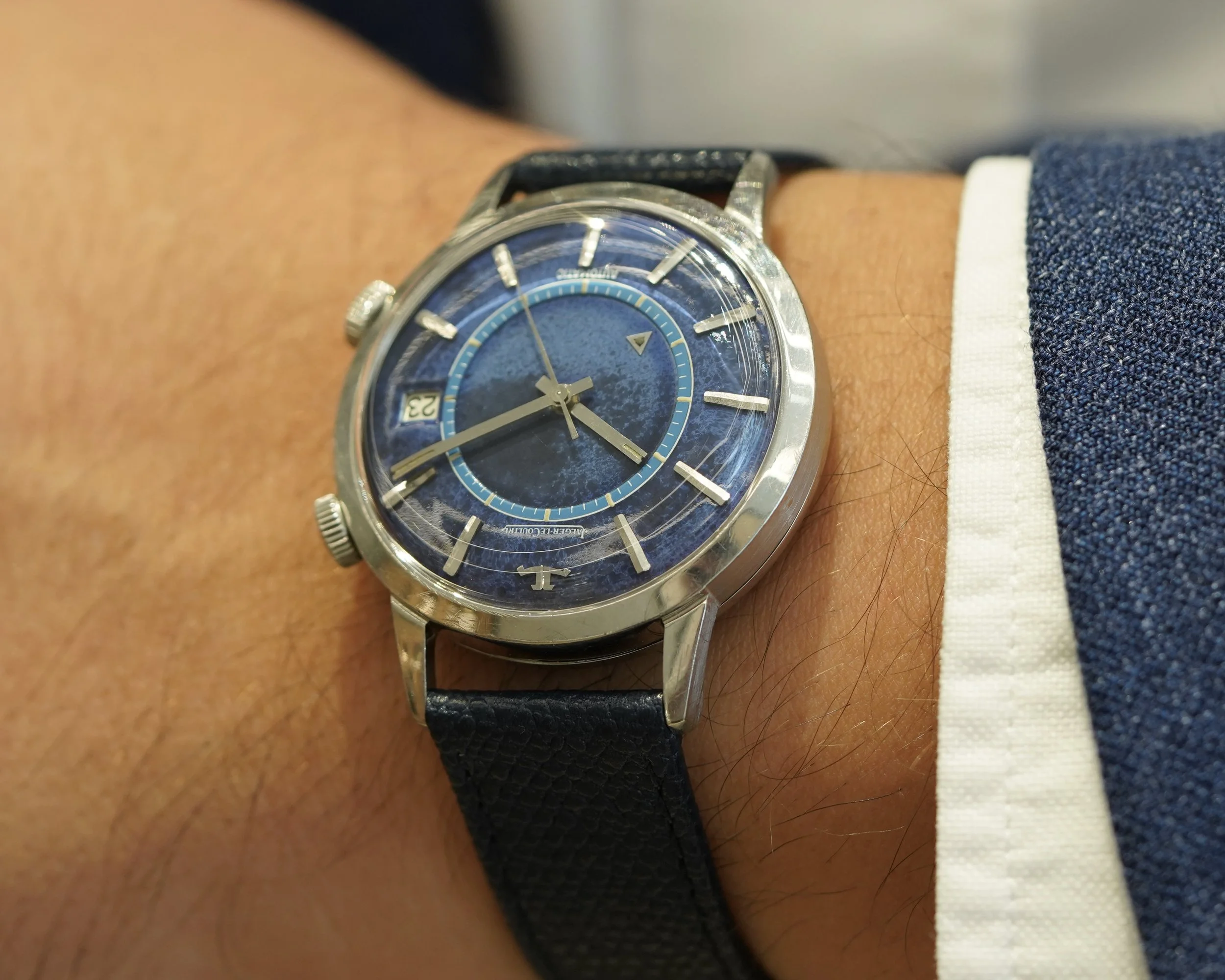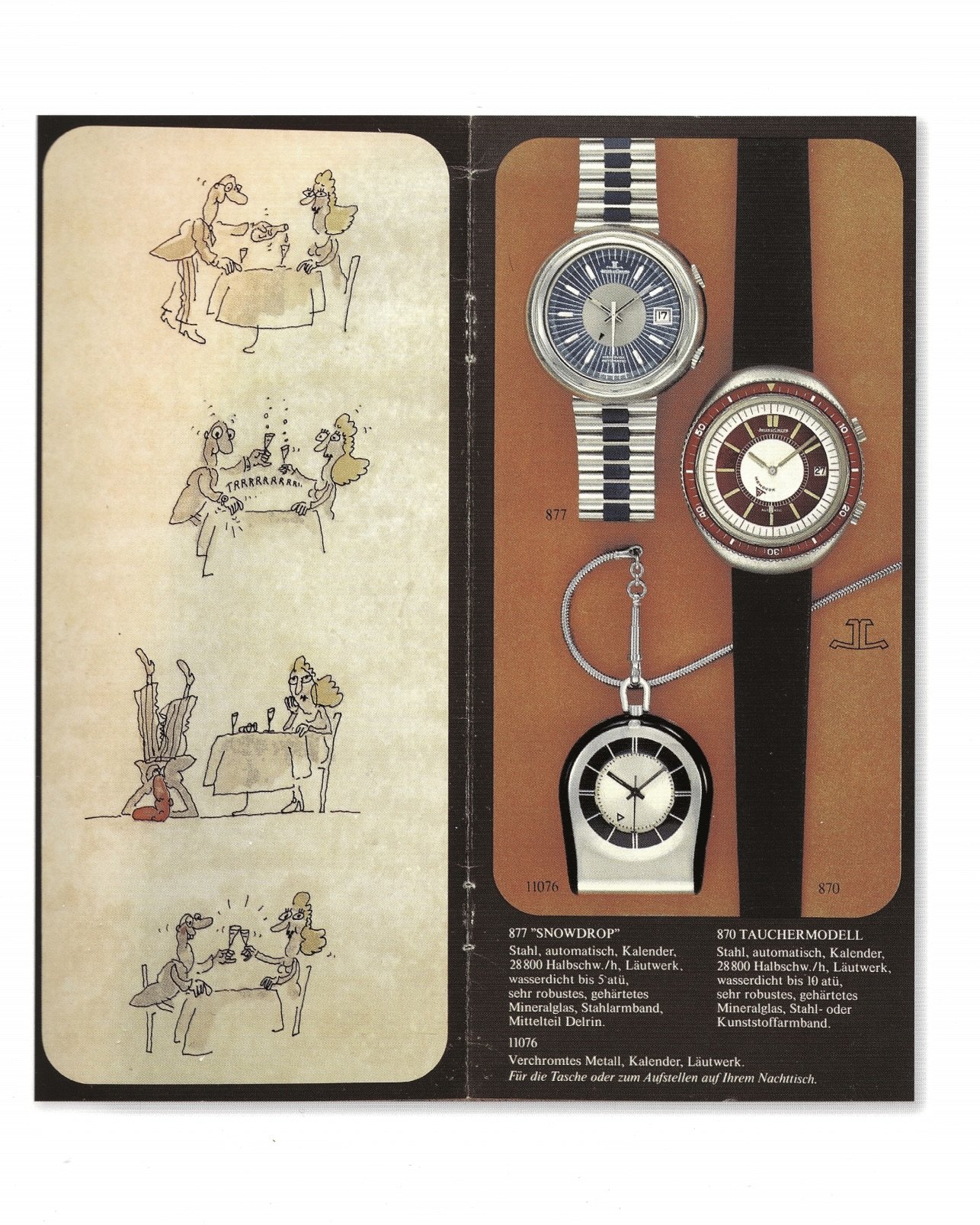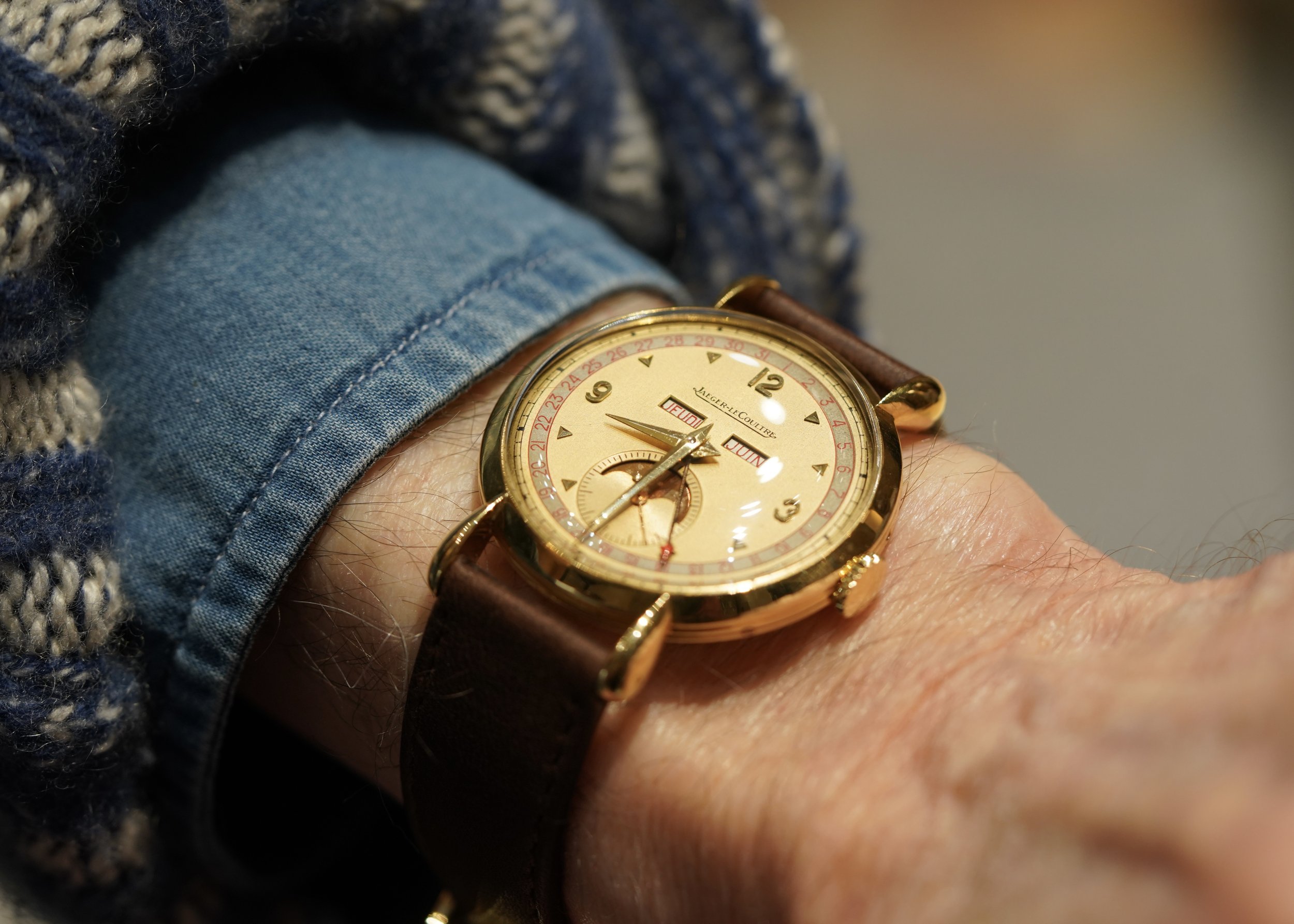The Collectibles Capsule from Jaeger-LeCoultre
By Charlie Dunne
Jaeger-LeCoultre’s The Collectibles - an offering of vintage timepieces direct from the company - is a masterclass in brand building and heritage storytelling. We had the opportunity to see their second / latest capsule of watches in Beverly Hills in June. The latest eleven vintage wristwatches came just four months after the initial round of twelve watches available in The Collectibles.
Speaking with Anne-Laure Ritter, President of Jaeger-LeCoultre Americas, she stated that the launch has been both an impactful experience for modern collectors and a fulfilling campaign for the manufacturer:
“It was an honor to launch this second capsule of emblematic timepieces among collectors, enthusiasts, and press at our flagship boutique on Rodeo Drive, paying tribute to the heritage and pioneering spirit of Jaeger-LeCoultre. There is something very special about a piece returning to where it was made 50, 80 years ago and seeing it fully restored and given a new lease of life for many more years to come.
Within each of The Collectibles lives a piece of the Manufacture's history. Having Matthieu Sauret join us in Los Angeles for this launch, and bearing witness to a shared passion for watchmaking was what made the evening so special.”
Both Eric Wind and I are huge fans of Jaeger-LeCoultre, with numerous watches and clocks in our personal collections. Over the past year, we have been amazed at JLC and the Heritage Department with endeavors such as The Collectibles. For the latest capsule, Wind Vintage was thrilled to admire and discuss some of the manufacturer’s historic timepieces in California with Product & Heritage Director Matthieu Sauret. Learn more about the timepieces below!
1930s Reverso with Central Seconds
Among the timepieces was an uncommon vintage Reverso with black dial and central seconds. It is only right that JLC would offer their signature model within the unique program, but this was quite an interesting and unexpected example! It dates to the 1930s and is powered by the calibre 437 with central seconds. These Reversos with central seconds are far less common than two-hand or subsidiary seconds models. Additionally, it features the much less common luminous dial in black. The watch was the among the nicest vintage Reversos I have seen in person and I was thrilled to go hands on with it. Thinking back to a previous discussion with Sauret, offering watches like this epitomizes his idea of a “traveling museum watch” and I’m sure the new owner is thrilled with this piece of history.
Image credit: hifi.archiv.info
Vintage Jaeger-LeCoultre advertisement circa 1941. Image credit: hifi.archiv.info
Image credit: hifi.archiv.info
Jaeger Duoplan Bracelet Watch
Another early timepiece offered in the curation was this elegant Duoplan in 18k gold with a black dial. One of the areas that Jaeger-LeCoultre was a significant contributor in is the wristwatches during the Art-Deco period, and their timepieces from the 1930s are truly amazing. This example was specific for the French market - featuring the “Jaeger” only signature on the dial. Interestingly, these small timepieces would be offered next to high-jewelry as Jaeger was a gem-setting atelier in France during the period. Matthieu Sauret would emphasize his experience growing up in France and share the reverence for JLC amongst collectors in the region. Like the United States, France was a particularly important market for Jaeger-LeCoultre in the 20th century. However, JLC has earned a higher degree of admiration from connoisseurs in France than perhaps any other region. Many exclusive models, such as Reversos, Duoplans, and the rare chronographs, can be found bearing the “Jaeger” only signature.
“At the dawn of the partnership between Jaeger and LeCoultre, the Duoplan represented a genuine industry revolution. Built on two superimposed planes, the Duoplan calibre was an invitation for both companies to express their creativity with beautiful and inventive designs. It was also a revolution for LeCoultre & Cie, which, thanks to the Duoplan, made the transition from a movement and component producer to a full-fledged watch manufacturer.” - Jaeger-LeCoultre
“Equipped with the Duoplan Calibre 403 with manual winding, this Duoplan is fitted with a magnificent gold bracelet that sits perfectly on the wrist.” Image credit: watchguy.uk
Image credit: Jaeger-LeCoultre
The Duoplan is a highlight within The Collectibles as these handmade micro-mechanical calibres are an incredible achievement by today’s standard - let alone nearly 100 years ago. These creations are a testament to why Jaeger-LeCoultre is such an eminent watchmaker with unrivaled pedigree.
Jaeger-LeCoultre Memovox “Ebony Indices” Reference E 855 on Gay Frères Bracelet
I’ve always been fond of the JLC reference E 855. It was my first vintage watch, and to this day it remains a special model to me. Currently, I am hunting for one in my own collection! This particular example puts that first JLC of mine to shame and has me eager to get a redeeming example from all those years back. It features a nice dial which is often not the case with these references. Despite being a waterproof case with the E designation (for etanche), these often have unfavorable dials due to water ingress.
It features what collectors refer to as “ebony” indices and an enclosed minute track near the interior disc. This layout is a great dial configuration in silver with a clean look and features the sharp-angled date window. The E 855 received quite a fair amount of attention at the boutique. Not to mention, it was paired on the Gay Frères bracelet made specifically for these Memovox models. Gay Frères is known for their unrivaled quality and iconic bracelets. Years later, JLC would transition to NSA bracelets. They look fantastic on the 1970s Memovox models, but as for comfort this GF bracelet is the best vintage bracelet for JLC! It has a great deal of nostalgia, and seeing it paired on the watch within old ads/catalogs always makes me smile.
Image credit: Jaeger-LeCoultre
Jaeger-LeCoultre Memovox “Lapis” Reference E 855
While previewing The Collectibles, I could sense Eric Wind was highly impressed with the watches - particularly the “Lapis” Memovox. “My favorite piece in this second capsule of The Collectibles was this Memovox reference E 855 with dial in the lapis lazuli style. The condition on the watch was outstanding with an unpolished case and spectacular dial and hands. I honestly thought long and hard about purchasing this watch for my own collection - it’s that good!”
I was pleased that a pair of reference E 855 examples were available in the latest capsule. The calibre 825 is a highly important movement, both for Jaeger-LeCoultre and for alarm watches as a whole. According to The Collectibles book, the cal. 825 would emerge in 1959. The following year, the reference E 855 would become the first automatic alarm watch with a calendar function. Mind you, JLC had just claimed the first automatic alarm watch with the calibre 815 earlier in 1957. This period was a defining chapter for the manufacturer, as they were offering an entire product line dedicated to the alarm complication. No other manufacturer was more specialized in this complication, and watches such as this “Lapis” Memovox are emblematic of JLC’s comprehensive catalog.
Futurematic Reference E 501
For those who appreciate more elegant timepieces with a bit of size, this reference E 501 is certainly one to consider. These jumbo models are incredibly cool. Introduced in 1951, the Futurematic was first wristwatch without a winding crown. While vintage-obsessed enthusiasts are familiar with the absence of the crown, it was quite fun to witness the surprise it evoked from some of the attendees. Sauret was particularly proud of the automatic Jaeger-LeCoultre models incorporating the power reserve (such as this Futurematic or Powerwind/Powermatic models). Interestingly, the American market would receive the first models. Two years later, these larger 37mm references were offered in the European market. While the American market examples certainly have flair and great dials, I am quite partial to these larger cases and stepped bezels.
“It ushered in the era of entirely automatic wristwatches and was the first fully automatic watch built according to the most modern principles without the conventional crown and winding mechanism. By eliminating the manual winding mechanism, Jaeger-LeCoultre’s watchmakers made room for a larger balance wheel. The latter was indeed 20% larger in the Futurematic, translating to enhanced precision. Its mechanism was therefore more sensitive and was set in motion by even the slightest movement of the watch.”
Speaking with Sauret, he would detail the importance of these timepieces. “Jaeger-LeCoultre introduced the first automatic wristwatches incorporating the power reserve indicator. These were a very sensible feature to have in the automatic models, as you were not winding the watch manually and it gave a visual cue for the remaining power reserve while on the wrist. This was the fashion of Jaeger-LeCoultre in creating new styles and patenting new movements. It remain as much a part of our history as it does today. We have created more calibres than any other watch company not strictly to sell to our clients but also to showcase our savoir faire and amaze the public.”
For those who appreciate the subject of patents, research and technical innovation, The Collectibles book was quite a remarkable read in the minutia included. One such example is the the manufacturer’s spotlight on their watchmaker Ferdinand [or Fernand] Reymond who was instrumental in developing calibres such as the 497 (Futurematic) and the aforementioned calibre 815 and 825 (Memovox).
Memovox Reference E 877 “Snowdrop”
Transitioning forward, I really appreciated the curation of alarm watches from the late 1960s-1970s. The Memovox has such a wide range of designs. Although I’m very much a fan of the classic manual wind examples, early waterproof and automatics, I can’t dismiss the stylish examples that emerged after within the high-frequency era.
The “Snowdrop' Memovox reference E 877 is an incredibly cool design for the 1970s. Designer and JLC collaborator Marc Newson was likely a fan of these models, as it possibly shaped the design of his Ikepod watches. I am quite attracted to these thick applied hour markers, and it reminds me a great deal of the Singer dials on many vintage Heuer chronographs from the period. These cases are incredibly nice on the wrist and are some of the best sounding alarms from the vintage catalog. The watch was paired on an original NSA bracelet which was very stiff and with the center links in black lucite, so kudos to JLC for this attention to detail. When you put the watch on your wrist, it felt as though it was a time capsule on the wrist.
Memovox Reference E 873 GT
The reference E 873 GT is one of the sleeper models within The Collectibles. I absolutely love the orange accents on the dial and the case is quite hefty. Like the Snowdrop, it features the amazing calibre 916. This calibre ushered in the bi-directional, fully-oscillating weight movements from the long produced bumper automatics which held rank within the manufacturer’s catalog over the preceding decade. The movement is where the “Speed Beat” nickname derives from as it operates at a frequency of 28,800 vph (or 4Hz). This high-beat movement incorporates a calendar function and was marketed for its improved precision. According to Watch Wiki, the 916 was “the first Jaeger-LeCoultre alarm calibre to use a high-speed [of] 28,800 [VPH] .”
Again, this model is worn on an NSA bracelet. They can look nice on a leather or suede strap, but I feel the the superior look is paired with metal. This period is uniquely interesting from a marketing perspective. Within catalogs, such as the image below, Jaeger-LeCoultre had a bit of cheekiness while communicating the cool alarm feature. While we certainly respect the serious watchmaking synonymous with Jaeger, the silly cartoons adjacent to the manufacturer’s Memovox models is atypical vibe from the [watchmaker’s] watchmaker.
Icons Miles Davis and Fred Savage are both fans of the Memovox watches in this case.
1970s Jaeger-LeCoultre Memovox Catalog For The German Market. Image credit: Strictly Vintage Watches
Memovox Polaris II Reference E 870 “Cranberry”
The aquatic sports models are where many collectors tend to spend heftier sums on the vintage Jaeger-LeCoultre. While first thought when the genre is mentioned is often the Polaris, the Polaris II reference E 870 is a superstar model which warrants a lot more praise. These maintain a large tonneau case and have very funky colors. It is possibly the most flamboyant timepieces in the manufacturer’s back catalog. This example is often referred to as the “Cranberry” due to the beautiful colored dial and bezel. Finding one in this shape is not common and I was extremely excited to see this one being offered! The dial had a very warm tone, and the bezel was extremely crisp. Unfortunately, I do not imagine I will come across a better example!
1970s Jaeger-LeCoultre Memovox Catalog For The German Market. Image credit: Strictly Vintage Watches
Deep Sea Master Mariner “Barracuda” Reference E 558
One example flew off the shelf at the JLC Beverly Hills party. Vintage watch specialist Josh Hendizadeh (@tropicalpatina) is very partial to this particular reference E 558 - also known as the “Deep Sea Barracuda”. “The gentleman’s diver, that’s the way I’d describe the Jaeger-LeCoultre Barracuda! Though you’d never know that from its nickname! This example, was in excellent condition having retained its original finish on the case along with a beautifully patinated dial with evenly aged lume! The Barracuda remains one of my favorite divers and certainly is a favorite from the vintage JLC collection! Fingers crossed that Monsieur Sauret will bring this icon back!”
Image credit: Jaeger-LeCoultre
Image credit: Jaeger-LeCoultre
This American-market Barracuda was a spectacular timepiece and featured a super sharp case made by Ervin Piquerez
EPSA advertisement circa 1955. Image credit: Europa Star.
Image credit: Europa Star (ASIA | 1971 | ISSUE #122)
Geomatic Reference E 398 “Full Set”
The final two timepieces within the capsule are my favorites. First, the Geomatic reference E 398. I haven't come across too many vintage Geomatics (or Geophysics) and this example was extremely strong. Despite being quite an elegant timepiece in 18K gold, the Geomatics were geared towards the “professional” client of the era. These individuals were in need of a high-quality antimagnetic timepiece to withstand their work environment, whether doctors or scientists. Few manufacturers focused on antimagnetic watches with the more rugged designs - such as OMEGA’s Railmaster, IWC’s Ingenieur or the Rolex Milgauss. However, JLC’s models achieved one of the most sophisticated offerings of the period.
These models quite literally have some of the best case backs on any watch. We see interesting medallions or logos on the case back from vintage watches, but this is one of those special designs from JLC. Like the JLC Sputnik boxes made for the Geophysic, this Geomatic case back is incredibly futuristic appears to be in a high-speed motion! Eric Wind said, “I can’t think of a cooler production case back than the Geomatic. It reminds me of the nuclear age and seems almost unreal when turning over the crisp watch to view the case back.”
The watch came with box and papers, and is accompanied by its chronometer certification paperwork. The whole package was just a beautiful thing to admire. I often get excited by ephemera, as it can sometimes be just as interesting as the timepieces! For the collector who purchased this watch, I have to imagine they are thrilled by the package deal!
The Complete Calendar Reference 2722
Closing out The Collectibles, the timepiece which I was most astounded by was the reference 2722 “triple” or “complete” calendar wristwatch with moon phase. As cited in the publication, these calendar models were the manufacturer’s “first major complication specifically designed for a [serially] produced wristwatch.” These timepieces emerged when wristwatches finally arrived and were becoming embraced within society during the 1940s. However, to wear a complicated model which exhibited your time relevant to the year was unimaginable to most consumers. The timepieces were launched in 1942 during a period of great pain and uncertainty. Yet, these timepieces are among some of the most beautiful and elegant wristwatches to have ever been produced.
This example was particularly breathtaking, as it featured applied-Arabic numerals. In addition, the applied-pyramid markers and large dauphine hands add incredible balance and beauty. These cases are far from water resistant, and as a result, most of these watches have fallen victim to poor restoration. The dial and moon phase were absolutely stunning. When I talk to collectors who may not familiar with JLC’s rich heritage, this is a watch I feel communicates how remarkable the manufacturer is.
During the event, I spoke with a gentleman wearing a stunning and complicated Reverso and a chambray shirt with a beautiful sweater. I was not surprised when I saw him gravitate towards the reference 2722. I had the pleasure of witnessing him express his interest in taking the timepiece home with him. The JLC team brought him back to set the date with the watchmaker in the boutique. This was a particularly memorable moment, as I was able to see the manufacturer find a new home, or “traveling museum” as Sauret referred to it, for one of the watches in The Collectibles.
I love sharing this true enthusiasm for vintage timepieces, and I will fondly remember this spectacular evening with fellow Jaeger-LeCoultre enthusiasts. Many thanks, again, to Jaeger-LeCoultre and their wonderful team for having us.
Learn more about JLC’s The Collectibles by following the link below:
https://www.jaeger-lecoultre.com/us-en/jaeger-lecoultre-collectibles-history







